Abstract
B6C3F1 mice were exposed by inhalation to 0, 3, 10, and 30 ppm methyl isocyanate for 2 hr followed by a 90-day recovery period. Sixteen of eighty (20%) male mice in the 30 ppm group died following exposure. There were no other unscheduled deaths in the mice. Five mice/sex/group were examined at 2 hr or at 1, 3, 7, 14, 28, 49, or 91 days following exposure. Chemical-related changes were restricted to the respiratory system. At 30 ppm there were extensive necrosis and erosion of the respiratory and olfactory epithelium in the nasal cavity. Severe necrosis and epithelial erosion were also found in the trachea and main bronchi. Regeneration of the mucosal epithelium occurred rapidly in the nasal cavity and airways. In the turbinates, mild incomplete olfactory epithelial regeneration persisted to day 91 in the male mice. Intraluminal fibrotic projections covered by respiratory epithelium and bronchial fibrosis were found in the major airways of the 30 ppm male and female mice by day 7. The intraluminal fibrosis persisted to day 91. In males with severe bronchial fibrosis, chronic alveolitis and atelectasis were found. In mice exposed to 3 or 10 ppm, persistent pulmonary changes were not found. These studies indicate that methyl isocyanate inhalation at or near lethal concentrations can cause persistent fibrosis of the major bronchi in mice.
Full text
PDF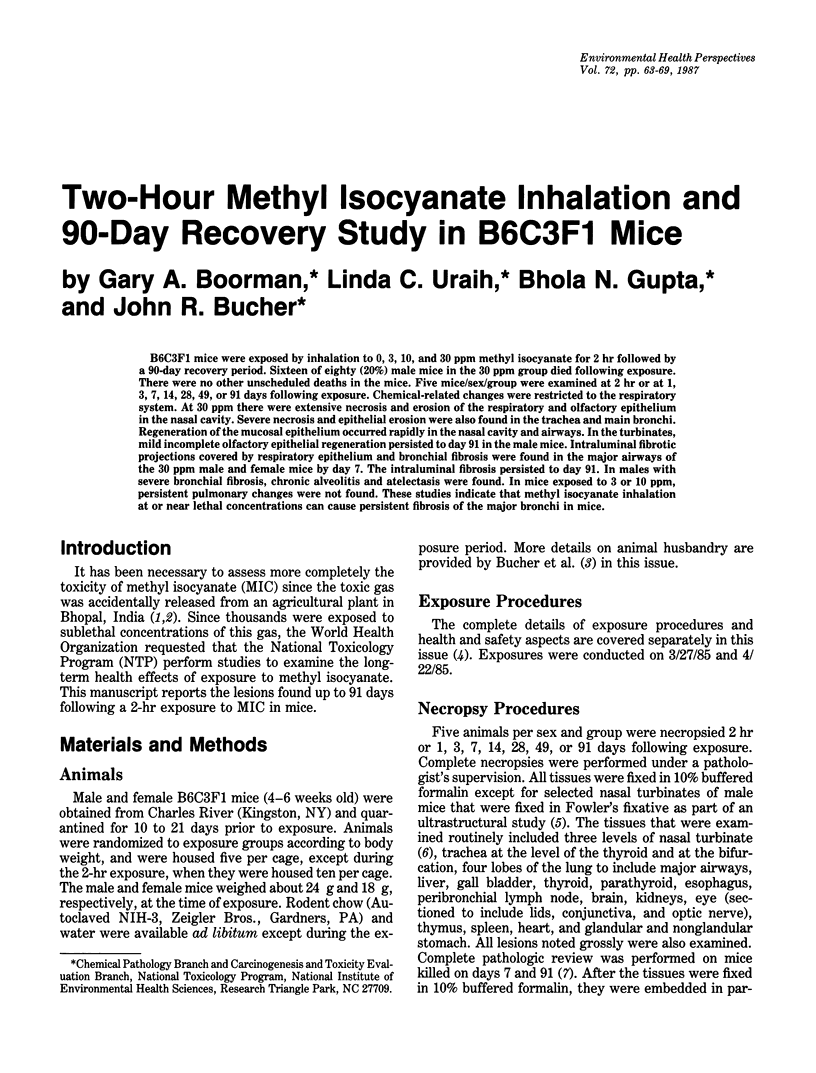

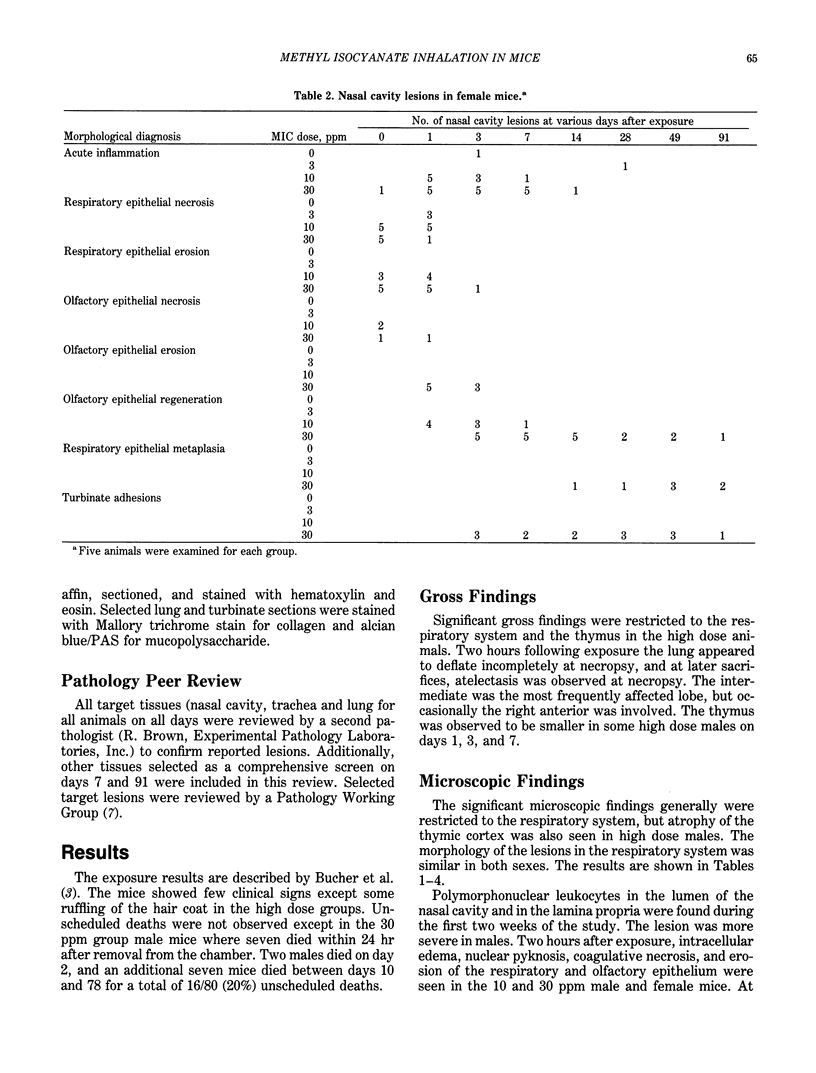
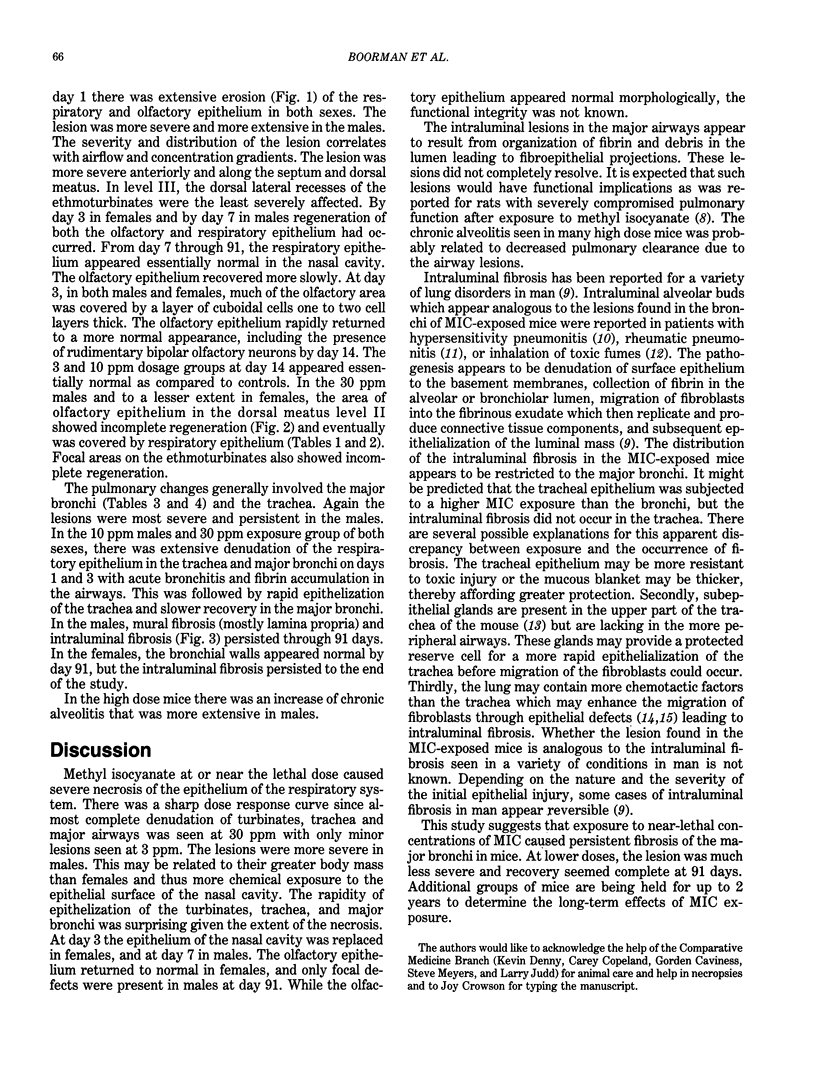
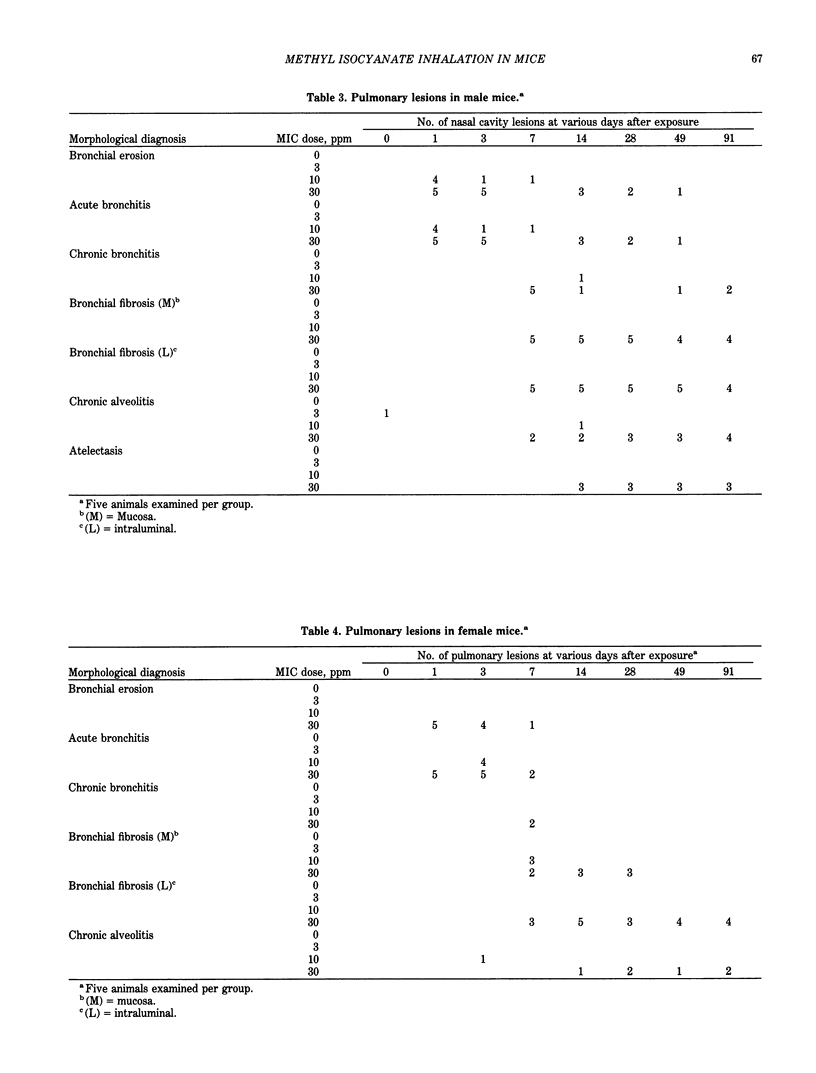
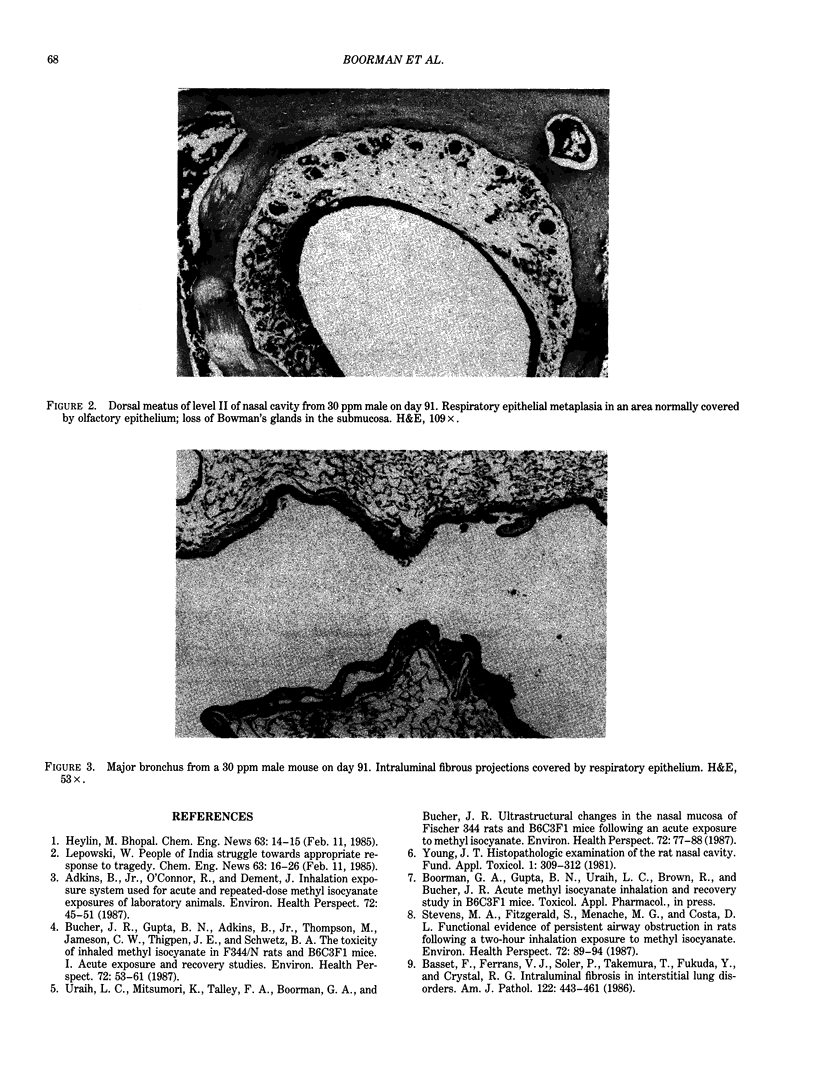
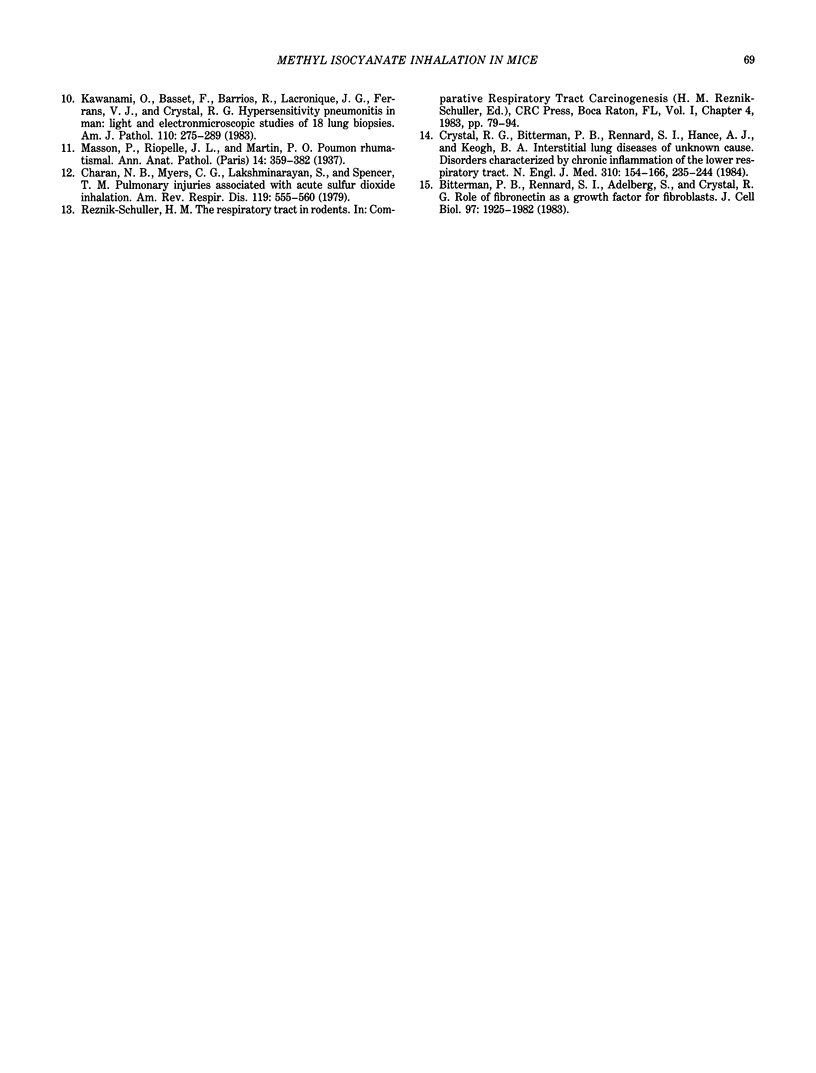
Images in this article
Selected References
These references are in PubMed. This may not be the complete list of references from this article.
- Adkins B., Jr, O'Connor R. W., Dement J. M. Inhalation exposure system used for acute and repeated-dose methyl isocyanate exposures of laboratory animals. Environ Health Perspect. 1987 Jun;72:45–51. doi: 10.1289/ehp.877245. [DOI] [PMC free article] [PubMed] [Google Scholar]
- Basset F., Ferrans V. J., Soler P., Takemura T., Fukuda Y., Crystal R. G. Intraluminal fibrosis in interstitial lung disorders. Am J Pathol. 1986 Mar;122(3):443–461. [PMC free article] [PubMed] [Google Scholar]
- Bitterman P. B., Rennard S. I., Adelberg S., Crystal R. G. Role of fibronectin as a growth factor for fibroblasts. J Cell Biol. 1983 Dec;97(6):1925–1932. doi: 10.1083/jcb.97.6.1925. [DOI] [PMC free article] [PubMed] [Google Scholar]
- Bucher J. R., Gupta B. N., Adkins B., Jr, Thompson M., Jameson C. W., Thigpen J. E., Schwetz B. A. Toxicity of inhaled methyl isocyanate in F344/N rats and B6C3F1 mice. I. Acute exposure and recovery studies. Environ Health Perspect. 1987 Jun;72:53–61. doi: 10.1289/ehp.877253. [DOI] [PMC free article] [PubMed] [Google Scholar]
- Charan N. B., Myers C. G., Lakshminarayan S., Spencer T. M. Pulmonary injuries associated with acute sulfur dioxide inhalation. Am Rev Respir Dis. 1979 Apr;119(4):555–560. doi: 10.1164/arrd.1979.119.4.555. [DOI] [PubMed] [Google Scholar]
- Crystal R. G., Bitterman P. B., Rennard S. I., Hance A. J., Keogh B. A. Interstitial lung diseases of unknown cause. Disorders characterized by chronic inflammation of the lower respiratory tract (first of two parts). N Engl J Med. 1984 Jan 19;310(3):154–166. doi: 10.1056/NEJM198401193100304. [DOI] [PubMed] [Google Scholar]
- Kawanami O., Basset F., Barrios R., Lacronique J. G., Ferrans V. J., Crystal R. G. Hypersensitivity pneumonitis in man. Light- and electron-microscopic studies of 18 lung biopsies. Am J Pathol. 1983 Mar;110(3):275–289. [PMC free article] [PubMed] [Google Scholar]
- Stevens M. A., Fitzgerald S., Ménache M. G., Costa D. L., Bucher J. R. Functional evidence of persistent airway obstruction in rats following a two-hour inhalation exposure to methyl isocyanate. Environ Health Perspect. 1987 Jun;72:89–94. doi: 10.1289/ehp.877289. [DOI] [PMC free article] [PubMed] [Google Scholar]
- Uraih L. C., Talley F. A., Mitsumori K., Gupta B. N., Bucher J. R., Boorman G. A. Ultrastructural changes in the nasal mucosa of Fischer 344 rats and B6C3F1 mice following an acute exposure to methyl isocyanate. Environ Health Perspect. 1987 Jun;72:77–88. doi: 10.1289/ehp.877277. [DOI] [PMC free article] [PubMed] [Google Scholar]
- Young J. T. Histopathologic examination of the rat nasal cavity. Fundam Appl Toxicol. 1981 Jul-Aug;1(4):309–312. doi: 10.1016/s0272-0590(81)80037-1. [DOI] [PubMed] [Google Scholar]





